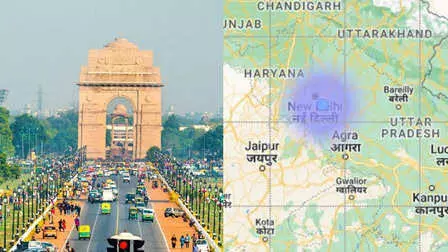The Looming Earthquake Threat in Delhi: Who Will Take Responsibility?

Delhi sits precariously in Seismic Zone IV, making it highly vulnerable to earthquakes. With a population of over 32 million, unchecked urbanization, and aging infrastructure, the city is dangerously unprepared for a major seismic event. The recent tremors felt across the capital serve as a stark warning, yet political responsibility for disaster preparedness remains an afterthought. Despite the scientific certainty that a major earthquake could strike, Delhi continues to gamble with the lives of millions by ignoring the critical need for preventive measures.
Delhi has witnessed a surge of illegal and unplanned construction in areas like East Delhi, Old Delhi, and parts of South Delhi, particularly near the Yamuna floodplains and unauthorized colonies. These structures, often built without earthquake-resistant designs, are potential death traps. High-density neighborhoods such as Karol Bagh, Laxmi Nagar, and Shahdara are especially vulnerable, with buildings constructed back-to-back, leaving little room for evacuation in the event of a disaster. The city’s chaotic urban sprawl, driven by population pressure and lack of affordable housing, has created an environment where safety regulations are routinely ignored.
The Delhi Master Plan mandates strict building codes and seismic safety norms, but these exist largely on paper. Poor enforcement, corruption, and negligence have turned large parts of the city into ticking time bombs. Builders often bypass safety regulations through illegal means, while authorities look the other way. Despite having institutions such as the National Disaster Management Authority (NDMA) and the Delhi Disaster Management Authority (DDMA), their impact on real-world disaster preparedness remains limited. Frequent drills, public awareness campaigns, and structural audits—essential measures for disaster preparedness—are either rare or poorly implemented.
The failure to ensure seismic safety is not just a technical lapse but a result of systemic governance issues. Successive governments, both at the state and central levels, have failed to make disaster preparedness a priority. Instead of investing in retrofitting weak buildings, enforcing zoning laws, and creating emergency response systems, political focus remains on short-term infrastructure projects that fetch votes. Flyovers, metro extensions, and beautification drives are showcased as development, while the fundamental issue of urban safety is neglected.
The Delhi Development Authority (DDA) and the Municipal Corporation of Delhi (MCD) are infamous for turning a blind eye to illegal construction, often in exchange for bribes. These agencies, meant to enforce building regulations, have instead facilitated their violation. In high-risk areas, illegal floors are added to existing buildings without any concern for structural integrity. Even after past disasters, such as the devastating 2015 Nepal earthquake, there has been no significant effort to strengthen Delhi’s structural resilience. Lessons that should have been learned from tragedies elsewhere have been ignored, and the same vulnerabilities persist.
The absence of political will to address earthquake preparedness reflects a deeper crisis of governance. Disaster management plans are drafted but rarely implemented effectively. Funds allocated for preparedness often vanish into bureaucratic inefficiency or corruption. There is little transparency in how resources are used, and no mechanism for holding officials accountable for lapses in safety measures. When minor tremors hit, authorities issue reassurances, but no concrete steps follow. The cycle of neglect continues, leaving the city dangerously exposed.
To mitigate the catastrophic impact of a major earthquake, urgent measures are needed. The first priority should be conducting structural audits of old and weak buildings, especially in high-risk zones, and mandating retrofitting to make them earthquake-resistant. Many of Delhi’s residential and commercial structures were built before modern seismic codes were introduced, making retrofitting a critical necessity. Additionally, strict enforcement of building codes must become non-negotiable for all new constructions. Builders who violate seismic safety norms should face severe penalties, and illegal constructions must be swiftly demolished.
Public preparedness is equally important. Earthquake response training should be made mandatory in schools, offices, and residential societies. Regular drills can significantly reduce panic and casualties during an earthquake. Each ward should have a trained local disaster response team ready to act immediately after a quake, ensuring that help reaches those in need without delay. Community-based disaster management not only saves lives but also reduces the burden on centralized response systems during large-scale emergencies.
Transparency and public involvement are crucial for building accountability in disaster preparedness. A public monitoring system should be established to track government spending on earthquake preparedness programs. Citizens should have access to information about which buildings have been retrofitted, where disaster response teams are stationed, and how emergency resources are allocated. An independent audit body should oversee disaster management funds and publish regular reports. Only through transparency can corruption be curbed, and only through accountability can preparedness improve.
Despite these clear solutions, the most significant obstacle remains the lack of political will. Earthquake preparedness is often treated as a technical issue rather than a governance priority. Political leaders rarely address it in their manifestos, and the media’s coverage of the issue is limited to when tremors are felt. This negligence persists because there is no immediate political gain from investing in disaster prevention. However, the cost of inaction will be catastrophic, and the consequences will be paid in human lives.
Delhi’s earthquake vulnerability is a governance failure, not just a natural risk. Political leaders need to stop treating disaster management as a secondary issue and make it a core agenda. The focus must shift from reactionary measures taken after disasters to proactive policies that ensure safety before the next big quake strikes. Preparedness should be seen as a long-term investment, not an expense. A resilient Delhi is not just safer but also more capable of sustaining its growth and prosperity.
The question remains: Will our politicians act before tragedy strikes, or will they only react once lives are lost? A major earthquake will leave no room for cover-ups or blame games. When buildings collapse and lives are buried under rubble, no amount of post-disaster compensation can replace proactive prevention. The time to act is now. The people of Delhi deserve not only promises but protection. They deserve a city that values their lives over political expediency. The responsibility is clear, and the consequences of inaction are inevitable. Who, then, will take responsibility before it is too late?
